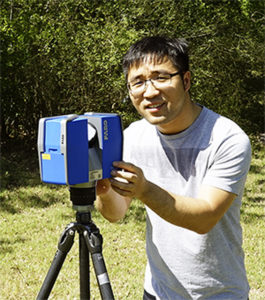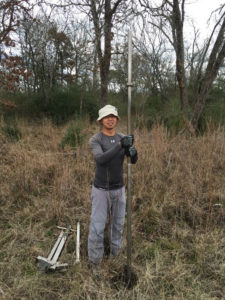Two Texas A&M ecosystem sciences research graduates earn distinguished student award
Writer: Kay Ledbetter, 806-677-5608, [email protected]
Contact: Dr. Yong Zhou, 979-587-4423, [email protected]
Dr. Thomas Boutton, 979-845-8027, [email protected]
Dr. Tan Zhou, 979-985-9138, [email protected]
Dr. Sorin Popescu, 979-862-2614, [email protected]
COLLEGE STATION – Two Texas A&M University department of ecosystem science and management students have been recognized for their research and named Distinguished Graduate Students for 2018 by the Association of Former Students.
Recognized are Dr. Tan Zhou, advised by Dr. Sorin Popescu, and Dr. Yong Zhou, advised by Dr. Thomas Boutton, all in College Station.
Popescu, a Texas A&M AgriLife Research scientist in the department, is on the Science Definition Team of the upcoming Ice, Cloud and Land Elevation Satellite-2, or ICESat-2, mission to provide guidance to NASA and helping the space agency define its science goals.

Tan Zhou’s research interests have focused on opportunities at the intersection of remote sensing, GIS, spatial statistical models and ecology. He is working with Popescu to develop validation plans for upcoming ICESat-2 satellite data and generating a model of the world’s tree canopy height for the ecological science community.
With aid from the National Science Foundation Doctoral Dissertation Improvement Grant, Tan Zhou’s research centers on developing algorithms for processing big datasets such as waveform LiDAR data and photo counting LiDAR.
He is studying their potential applications in forest structure characterization and biomass mapping using machine-learning methods, such as Random forests and Bayesian inference, both popular statistical techniques used in modeling.
Several pieces of Tan Zhou’s research have been published in top journals of the remote-sensing field such as Remote Sensing of Environment, including the most recent “Bayesian decomposition of full waveform LiDAR data with uncertainty analysis” in October 2017.
Zhou has also spent four years as a teaching assistant for undergraduate and graduate courses in GIS and remote sensing.
Tan Zhou earned his bachelor’s degree from Tianjin University of Science and Technology and a master’s from Beijing Normal University before coming to Texas A&M.
Yong Zhou is working with Boutton, who is a Regents Professor and Sid Kyle Endowed Chair in Semiarid and Arid Land Biogeochemistry. While at Texas A&M, Yong Zhou directed his research at understanding how woody plant encroachment into grasslands and savannas alters spatial patterns of soil biogeochemical properties and processes at the landscape scale in the southern Great Plains.

About 20 percent of the land mass worldwide and about 50 percent of Texas is classified as savanna. Trees and shrubs are rapidly becoming more abundant in these savannas globally, and are changing the biogeochemistry of those ecosystems in ways that could have implications for global environmental change.
Yong Zhou has received multiple research grants and fellowships, including the NSF Doctoral Dissertation Improvement Grant, an Explorer’s Club student grant and a College of Agriculture and Life Sciences Tom Slick fellowship, to support his research. He has published 16 peer-reviewed articles in scientific journals such as Global Change Biology, Ecology, Journal of Ecology, Landscape Ecology and Soil Biology and Biochemistry.
Earlier this year he published “Soil phosphorus does not keep pace with soil carbon and nitrogen accumulation following woody encroachment” in the journal Global Change Biology.
In that research, Yong Zhou determined the transfer of phosphorus from deeper to shallower portions of the soil profile may enable the persistence and ongoing encroachment of woody species, which have relatively high tissue phosphorus concentrations compared to the grasses and forbs that are being displaced. The more favorable nutrient status of woody plants fosters higher rates of primary production and enhances soil carbon storage under their canopies.
“Characterization of the spatial variability in phosphorus storage and dynamics in horizontal and vertical soil space in response to this vegetation change could improve efforts to model the interactions between vegetation change, biogeochemistry and the climate system,” Boutton said.
Yong Zhou earned his bachelor’s degree from Northeast Normal University and his master’s in ecology from Institute of Botany, Chinese Academy of Sciences. He has accepted an offer for a postdoctoral fellowship from Yale University, where he will explore impacts of woody cover increase in African savannas on ecosystem functioning and services.


